Qualcomm Institute Launches Third Season of Tech-Enabled Performances
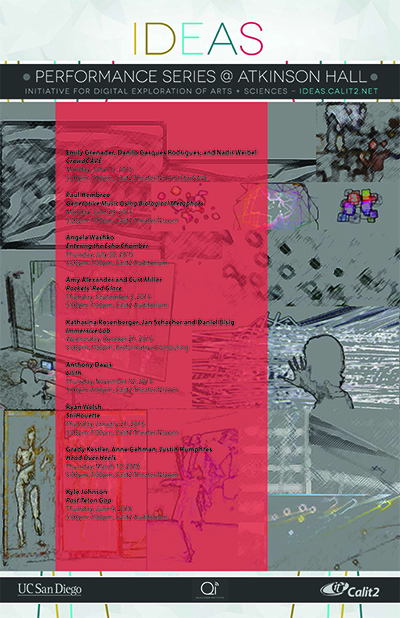
Eight works in 2015-'16 IDEAS season of performances
San Diego, May 20, 2015 — On June 15, the Qualcomm Institute will kick off its new season of eight works involving residencies and performances funded by the institute’s Initiative for Digital Exploration of Arts and Sciences (IDEAS). The interdisciplinary work, titled CrowdCAVE, will use two of the Qualcomm Institute’s key visualization spaces: the StarCAVE virtual-reality environment, where small groups of visitors are surrounded by a virtual crowd to which they are added; and the large-scale Vroom display wall next door in the Calit2 Theater, which will showcase the full breadth of the virtual group portraiture. “By using the Vroom display wall,” says UC San Diego visual arts lecturer Emily Grenader (MFA ’13), “we will be able to adequately show the ties between individuals at different locations performing in different ways.”
Grenader’s CrowdCAVE is one of two works by visual arts faculty or students; the other is Amy Alexander and Curt Miller’s Rocket’s Red Glare. Five works are primarily by composers and sound designers from the Department of Music, and one performance features a team of first-year MFA students from Theatre and Dance (although Theatre and Dance professors and students are participating as collaborators in a number of projects). In addition to the Qualcomm Institute, the IDEAS series is supported by the Office of the Dean of Graduate Division.
The selection committee, which was composed of 11 faculty members, had a difficult time in choosing among the 28 submitted proposals due to the exceptional quality of the ideas and projects proposed. “We are very excited that the projects this year are more diverse in their interdisciplinary nature,” said IDEAS director Shahrokh Yadegari, a professor in Theatre and Dance. “The proposals were also more adept and strategic in taking advantage of the state-of-the-art technologies available to them at the Qualcomm Institute.”
Emily Grenader, Danilo Gasques Rodrigues, and Nadir Weibel
CrowdCAVE
Monday, June 15, 2015
5:00pm-7:00pm, Calit2 Theater/Vroom/StarCAVE

Visual Arts’ Emily Grenader teamed with Computer Science and Engineering research scientist Nadir Weibel and Brazilian undergraduate exchange student Danilo Gasques Rodrigues to work with 15 graduate and undergraduate students from ICAM and CSE last summer to tag and organize individual video portraits based on action, emotion, age, and movement. “We wanted to be able to better understand how visitors to interactive installations react to a crowd of strangers and the possibility to be part of it, as well as how this paradigm can be used to augment social interactions,” explains Grenader. “To properly show our data, we need to display our findings visually, and that’s where the Vroom display system comes in.” During the performance, the high-resolution ‘moving’ portraits of the latest visitors are merged on the Vroom display so that the full impact of the crowd can be felt across the Vroom’s 30-feet by 15-feet expanse (but with each face in the crowd clearly visible because the video portraits are captured at high resolution). The final performance will also take advantage of similar portraits captured over the past two years by Grenader’s VideoMob project. “We will organize a presentation that allows us to dynamically display our visual research,” she adds, “while also leaving time for the public to connect to the interactive installation by recording their own videos that will instantly be added to the crowd.” Undergraduates Sylvia Li (InterdisciplinaryComputing in the Arts major) and Jimmy Nguyen (CSE) joined the team in 2015 to help create CrowdCAVE.

Paul Hembree
Generative Music Using Biological Metaphors
Monday, June 29, 2015
5:00pm-7:00pm, Calit2 Theater/Vroom
Paul Hembree is a composer and Ph.D. student in the Music department at UC San Diego. His work explores the boundaries between the perceptual categories of sonic materials and the processes that guide them, navigating what he calls “the space between organic and synthetic sounds in a search for uncanny or sublime hybrids.” This performance will feature four of the seven digital audio-visual works Hembree created between 2009 and 2014 as Cellular Automata Studies series. The computer-music composer’s goal is to create more experimental sounds, using a model in which harmonic proximity correlates to spatial proximity (e.g., octaves are represented as short distances). “The use of this spatial model is not intended to generate strictly traditional musical behavior, but rather to allow for a predictable baseline of harmonic relationships which serve as a point of departure for the creation of more experimental sounds,” says Hembree. Each of the cellular automatons is an instrument playing with light and sound based on a combination of synthetic biological mechanisms and multi-dimensional models of pitch perception. “I use a method of excitation that is used in other contexts to mathematically model the expansion of populations of living cells, forest fires, or the activity of neurons,” explains Hembree. “In the performance of these works, I create musical behavior and drama by manipulating cellular activity (by turning on or off certain cells) or environmentally (by changing the rules under which the cellular automaton operates), while navigating the virtual space and highlighting the sound and light activity at various locations.” Some of the rules allow for the evolution of emergent structures – persistent patterns that are the product not of direct user control, but of local interactions.
Amy Alexander and Curt Miller
Rockets' Red Glare
Thursday, September 3, 2015
5:00pm-7:00pm, Calit2 Auditorium
UC San Diego visual arts associate professor Amy Alexander premiered an earlier work, Discotrope: The Secret Nightlife of Solar Cells, in Atkinson Hall’s gallery@calit2 in 2012, and she showed subsequent works SVEN and DIVA at the Filmatic Festivals in 2014 and 2015, both in the Qualcomm Institute. For this early-September performance, Alexander is back in the 200-seat Calit2 Auditorium with clarinetist and sound artist Curt Miller, a DMA student in the Music department, with Rocket’s Red Glare, an improvisational composition derived from YouTube videos of explosions. The work marks the debut performance for Alexander’s Percussive Image Gesture System (PIGS), a software/hardware visual instrument that allows for emotive, gestural cinematic performance. “The instrument works from the premise that new methods of visual expression can be formed when we think of cinema as fluid and performative, and they can work beyond traditional cinematic constraints of rectangular images and linear playback,” says Alexander. “PIGS uses percussion and music as part of its approach to cinematic performance, rather than attempting to match sound directly to the on-screen image.” The system allows a performer to combine scribble-like swipes and drum stroke gestures in a “theme and variation” framework to perform a multilayered, cinematic composition that drifts between the literal, the metaphorical and the abstract. For the debut of PIGS, Alexander and Miller developed Rocket’s Red Glare to play with the public fascination with, and aestheticization of, things that explode. Alexander’s software allows her to use iPads and MIDI drums to perform the videos as fluid forms. Curt Miller has developed a custom software application that allows him to create a soundscape that is both algorithmic and improvisational, integrating the YouTube sound samples with live and recorded clarinet. The performance will be followed by a brief Q&A with the artists.
Katharina Rosenberger, Jan Schacher and Daniel Bisig
Immersive Lab
Wednesday, October 21, 2015
5:00pm-7:00pm, Performative Computing

UC San Diego composer and professor of music Katharina Rosenberger is collaborating with artists from Switzerland’s Institute of Computer Music and Sound Technology (ICST), Jan Schacher and Daniel Bisig, to deploy their Immersive Lab platform as a media space in the Performative Computing Lab in Atkinson Hall. Originally developed at ICST, the lab integrates panoramic video and surround audio with full-touch interaction, i.e., where the entire screen serves as a touch surface. While the Immersive Lab is deployed for a month-long residency starting October 7, groups of UCSD graduate and undergraduate students will be recruited to learn the system and develop creative work for the unique installation in collaboration with confirmed faculty participants, including Katharina Rosenberger, Miller Puckette (Music), Peter Otto (Music), Shahrokh Yadegari (Theatre and Dance), Ricardo Dominguez (Visual Arts) and David Kirsh (Cognitive Science). For the final performance, their works in progress will be performed along with existing pieces previously created for the Immersive Lab at ICST. “The compositions can be collaboratively created and combine visual and sonic material with generative and algorithmic methods,” says Rosenberger. “The artistic approach focuses on real-time pieces that involve visitor interaction and that take advantage of the panoramic nature of the installation.” In particular, the works should articulate the relationship between immersive media and direct interaction, with special focus on group-embodied interaction, gesture tracking, tactility within the digital realm, and immersive as well as explorative audio-visual environments.
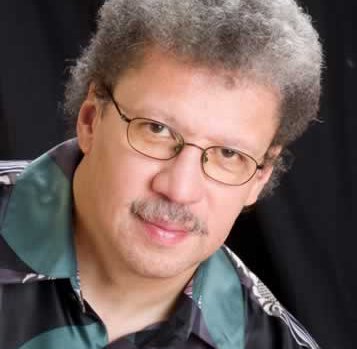
Anthony Davis
Lilith
Thursday, November 12, 2015
5:00pm-7:00pm, Calit2 Theater/Vroom
UC San Diego music professor and composer Anthony Davis’s opera Lilith with a libretto by Marshall College provost Allan Havis based on his original play of the same title, will be directed by Keturah Stickann with sound design by Theatre and Dance professor Shahrokh Yadegari. The opera explores and celebrates the ageless erotic myth of Lilith, the woman who preceded Eve in the Garden of Eden. This will be the first staged workshop performance of the opera for piano and sound as well as six singers. “Lilith blends a variety of powerful musical tropes from jazz and blues to classical as it reenacts the tale from a twin timeframe of contemporary America and the beginning of Paradise,” say Davis. “In the personage of Claire, Lilith shocks the modern-day Eve in a restaurant when she asks her rival if her husband could just be with Claire for one day.” Eve, in the person of Eppy, immediately suspects that her husband has some awareness about this intrusion. “The opera returns to a divorce hearing in Paradise where Adam presents his real and imaginary marital grievances to an invisible angel,” adds Havis. “The unfolding story points up the sexual and moral entanglements, as we see that Lilith received a miscarriage of justice at the beginning of time and that a paradoxical cycle of reunion, rivalry and revenge can never end.” In addition to her seduction of all married men, Lilith goes after young boys, triggering a subplot in the opera involving the abduction of Eppy’s son, Earl. In the opera’s finale, Eve must adopt elements of Lilith in order to vanquish her from her own domestic world. Helping to stage the workshop performance will be two designers from the MIT Media Lab’s Opera of the Future group, Elly Jessop and Peter Torpey. “We want to use technology not only to create the elaborate smoke and mirrors that Lilith/Claire conjures onstage, but also to allow the character to creep into the audience,” says composer Davis. “We will explore ways in which Lilith may engage audience members directly, creating the impression of omnipresence and personal violation that are the essences of the character. Audiences can then become part of the world of our story, through the conduit of Earl’s video game,” with which the audience can interact.
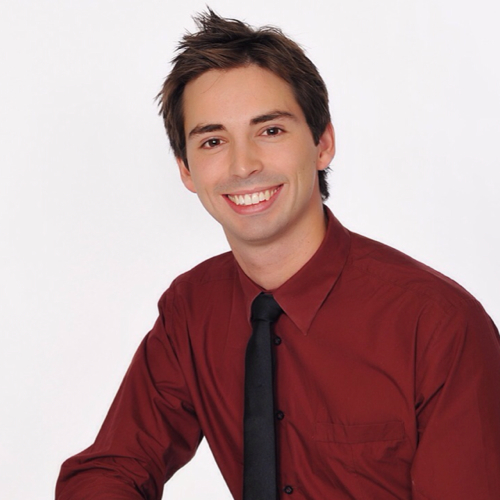
Ryan Welsh
StilHouette
Thursday, January 21, 2016
5:00pm-7:00pm, Calit2 Theater/Vroom
Ryan Welsh is a Ph.D. student in the Music department (MA ’11) and a composer who worked previously on productions involving the Vroom display wall in the Calit2 Theater (including Crossing Boundaries in 2014). In StilHouette, he composes simultaneously for light, sound, and space, integrating the use of a DL-1 combo camera/projector and a 4K video projector to enhance the viewer’s experience of dancers’ movements. In addition to dancers Dina Apple and Emily Aust, StilHouette is a multi-movement work incorporating live music performance (with flutist Michael Matsuno), live processing, pre-recorded sound, video (by videographer Huy Trihn), lighting and projection. “The relationship between sound and its reverberance is typically fixed and thus heard as just a single event, but in StilHouette this relationship will become dynamic, expressive and interactive,” says Welsh. “The force of the visual to impress and alter the experience of the aural as well as our desire to attach the visual to the aural will be explored.” Novel technologies and capabilities available only through Calit2’s Qualcomm Institute will be integrated with contemporary music and dance practice. Welsh’s performance will also feature 10.2 surround sound with live input from wireless microphones on the musician and the two dancers.

Grady Kestler, Anne Gehman, Justin Humphres
Head Over Heels
Thursday, March 10, 2016
5:00pm-7:00pm, Calit2 Theater/Vroom
Head Over Heels uses the human body as a vehicle for transformative experiences during live performance, integrating technologies such as gesture-controlled armbands paired with infrared tracking technology and real-time image processing. “In the 21st century we are experiencing how our interactions with technology have the ability to breed interconnectivity, while simultaneously separating us from our corporeal, somatic sensibilities,” says UC San Diego MFA sound-design student Grady Kestler. “Head over Heels will explore that paradox.” Kestler’s work features choreography by Anne Gehman and the use of a virtually interactive space facilitated and designed by Kestler and Justin Humphres (all three are first-year MFA students in the Theatre and Dance department). Through live performance, the work will examine the interactivity between creator, performer and spectator, using spectator participation as part of the choreographed live performance.
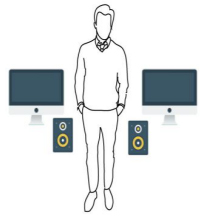
Kyle Johnson
Past Teton Gap
Thursday, June 9, 2016
5:00pm-7:00pm, Calit2 Auditorium
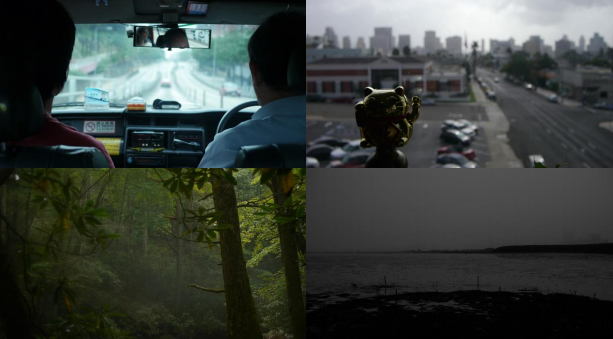
Kyle Johnson is a Ph.D. candidate in Music (composition), and his multimedia creative works combine elements of music, video and spoken word. In his newest work, Past Teton Gap, Johnson uses multimedia artwork for a performer, multiple video displays and recorded sound to explore ideas of fiction, devotion, intimacy and skepticism. Through nine scenes, each combining elements of music, theater, cinema and poetry, Past Teton Gap will explore the excitement of fiction, lies, and the staged, the tension between complete devotion and pragmatism, the intimacy of performance and the state of skepticism. Standing between two video displays and stereo loudspeakers, the performer delivers a stylized speech-song while being accompanied by recorded and synthesized sounds. Throughout the presentation, the performer interacts with composite video being shown on one or both video displays, and the video will be produced in the 4K format (four times the resolution of HDTV) during two days of production in the Calit2 Theater during Johnson’s IDEAS residency. The use of 4K video will allow the artist to manipulate aspect ratio (the relationship between width and height of the projected image) as a dimension for creative expression by experimenting with aspect ratios other than the standard 16:9 ratio of high-definition video. The final performance will take place in the Calit2 Auditorium.
Related Links
Media Contacts
Doug Ramsey, (858) 822-5825, dramsey@ucsd.edu
IDEAS Contact: Trish Stone, tstone@eng.ucsd.edu
